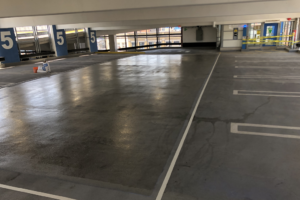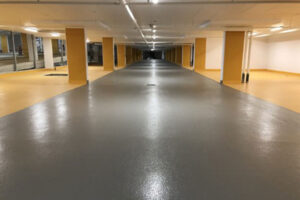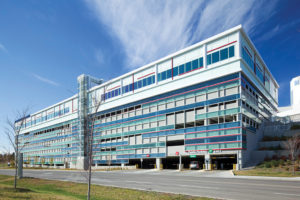5 best practices for maximizing the service life of your traffic deck coating
By Bryant Bortolotto-Freeman
If your building includes a parkade, chances are you’ve witnessed the wear and tear that comes from steady usage and exposure to moisture and contaminants like road salts. Even if the parking area is located indoors, the traffic deck coating (TDC) used to protect concrete surfaces will deteriorate over time, reducing its ability to effectively do its job.
“Traffic deck coating plays a key role in preserving concrete’s structural integrity, so it’s important to ensure it performs as intended,” said Bryant Bortolotto-Freeman, Engineer-in-Training at RJC Engineers. “By understanding the causes of concrete deterioration and following certain best practices to maximize your TDC, costly repairs to your concrete may be averted.”
What is Traffic Deck Coating?
A TDC is a multi-coat system formulated to protect concrete structures and structural elements from contact with moisture and contaminants. Typically, they are made up of a primer (polyurethane or epoxy-based), a basecoat, and a topcoat that work together to provide waterproofing protection, traction enhancements, wayfinding and light reflection in parkades and other concrete enclosures. Although usage of TDCs is widespread in North American, Bortolotto-Freeman has seen all-too often what happens when maintenance is ignored, or improper application creates weaknesses in the system. Common failures include debonding of the coating from the underlying substrate (or between the layers, cracks and scrapes letting in moisture, and surface damage from abrasion due to wheel racking and traffic exposure.
To prevent a failure and prolong the service life of your TDC, Bortolotto-Freeman recommends the following 5 Layers of Success:
Layer 1 – Surface Prep
Thorough surface preparation is crucial for a successful TDC installation, whether it’s brand- new concrete or an existing slab undergoing…
By Mathieu Verronneau, ing. & Paul Hanratty, MBA
Condominium Parking Garage Maintenance
Introduction
Your parking garage, if not maintained properly, can be one of the most expensive costs to your Condominium Corporation. Repairs to your garage can cost millions of dollars and create massive disruption over multiple years to the quiet enjoyment of your home and investment.
Background
The National Building Code Standard for Parking Structure construction and protection is CSA S413, “The Canadian Parking Standard”. This building code document provides guidance for designers and builders of parking structures. The current issue of this standard is a highly informative document but falls short in several areas related to protection of structural elements within parking structures. Deterioration of structural elements like columns, slabs, ledge beams etc., accelerates quickly if these elements are not protected. De-icing salts greatly accelerate the deterioration of unprotected structures.
One can find all details on this standard at:https://www.csagroup.org/store/product/S413-14/
Historic Building Process
Condominium structures are built by property developers and in most urban settings the parking garage is generally underground. Developers have a two-year obligation to the Condominium Corporation covering non-structural and non-life safety components of the building. This includes waterproofing structural elements in the parking garage and elsewhere. The short warranty period incentivizes some developers to install the minimum protection required by the building code. The current code only requires that elevated slabs be protected by an elastomeric membrane and traffic bearing surface. It does not require that the Architect or Designer of structural protection systems design for durability. This lack of guidance in the building code will be changed significantly with the new iteration of CSA S413:21, due to be released later in 2021. The new code will require that deck membrane systems be designed to receive four distinct levels of…
By Ralph Bond
It seems that almost every week there is a news article about how the fast approaching world of autonomous vehicles (AV’s) will change the way we travel, impact on transportation related infrastructure – especially parking, and influence planning and design for urban real estate development. There is a wide divergence of opinion on when and how the impacts might occur and many unsubstantiated pronouncements. Nevertheless, an increasing number of developers as well as public sector agencies and municipalities are becoming concerned about the potential impacts and the risks associated with building new infrastructure that may not be suitable for the future.
The increased use of ride hailing services like Uber and Lyft is already reducing parking demand in varying degrees. For example, hotels in urban areas are reporting substantial reductions in parking demand because people are increasingly using ride-hailing services in place of rental cars. Some airports are also reporting significant declines in parking demand. More business people are using ride-hailing services in place of driving in some congested urban areas because it allows them to work while travelling and avoid the frustration of finding a parking space. Although these examples do not apply universally, it is an indication of how business related travel is changing when it comes to mobility in congested urban areas. We therefore prefer to think of the issue as the increased use of ride hailing services whether they are in autonomous vehicles or not.
Increasingly, both the public and private sector are asking questions such as:
- Do we really need this much parking?
- What is the risk that we will be stuck with a stranded parking asset?
- Can parking be designed for conversion to another use to mitigate the risk?
- Can increased use of shared public parking mitigate future risk?
- Will a lot more…
By Chris Davis, BSc, P.Eng., CEng, MICE, MIStructE, LEED® AP | Principal, RJC Engineers
The right parking plan is critical to the success of a parkade project – it strongly influences the budget and ultimately, the long term success for the owner. Determining an optimal plan requires careful, thoughtful design with experience and expertise in parking planning, but it also requires a fundamental understanding of how structural systems are integrated. The ideal solution provides a highly functional layout within an economical and easily constructed building.
No two buildings are ever the same. In order to meet the vast range of challenges that are presented throughout any given project, parking structure designers need to understand the objectives of their clients and the demands of the industry before beginning the design of a building. If they fully understand what the requirements and priorities are, they are better equipped to develop an optimal solution that can perform a range of functions – taking into account current and future uses.
Our industry is facing the impending probability that the presence and use of motor vehicles will soon be seeing major changes. With these changes, we will see the inevitable reduced demand for parking structures as we know them today. The parking industry, understandably, is starting to reconsider how parkades should be constructed for the future, with design life to structural codes of a minimum of 50 years. It is unlikely that many of the parkades we build today will be used in the same way in 50 years’ time. So, how do we make these purpose-built, one-function structures suitable for future use, when it’s so difficult to predict what they will need to do?
TRADITIONAL PARKING DESIGNS
Parking planning involves the efficient layout of traffic flow (entries, exits, circulation, etc.) and stalls within a given footprint. Developing the…
By Jay Boychuk and Lisa Oelke, hb Solar Canada
Parking lots are assets for those that charge for the spaces within them, or need them to attract customers or even employees. They serve one main purpose, to provide a place to leave cars, whether it is for an hour, or a day. What if that asset could be turned into a multi-purpose piece of land that not only provides parking, but generates additional cashflow, and helps the environment? Parking lots can do a surprising thing, they can generate electricity, and not only that, its green energy. Introducing solar covered parking can do just that.
Why would a parking lot operator want to be a producer of green energy? Large cities can have a tremendous amount of asphalt covered surfaces, some above 40% of their land mass. Suburban areas don’t escape these large amounts of asphalt coverage either. A lot of that density is roadways, with surface parking lots significantly adding to the total as well. What does all this asphalt do to our environment if we just use it for parking cars?
When it comes to identifying the greatest challenge to meeting Green House Gas (GHG) reductions, transportation leads in Ontario as the single-largest emitting sector in the economy at 35%. In response to these statistics, the Ontario Government is encouraging drivers to switch to electric vehicles, (EV’s) by offering rebates of up to $14,000 with the purchase of an EV. Quebec and B.C. have similar statistics and have also offered incentives. The Electric Vehicle Chargers Ontario(EVCO) incentive serves to increase access to charging stations with funding to build a network of fast-charging EV stations in cities, along highways, at workplaces, apartments, condos, and public places across Ontario. These measures create demand for additional EV charging in locations where cars need
to park…
Wondering if anyone in the industry have tendered for LED conversion for a Parking Structure and if so, would you be willing to share your tender.
Stephane Thibodeau (City of Moncton) | stephane.thibodeau@moncton.ca








